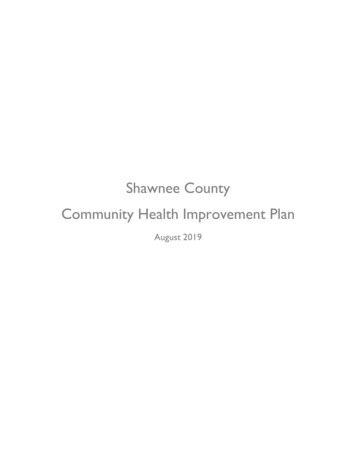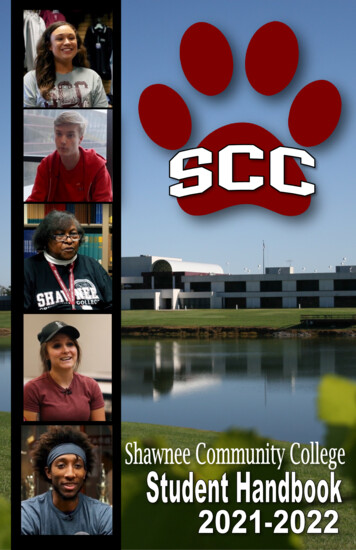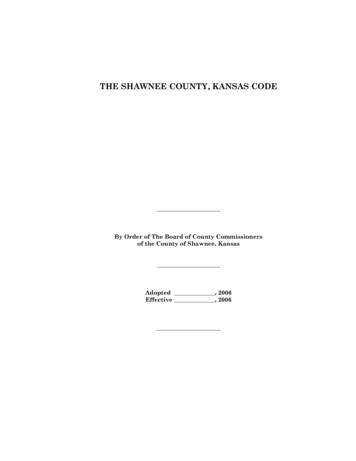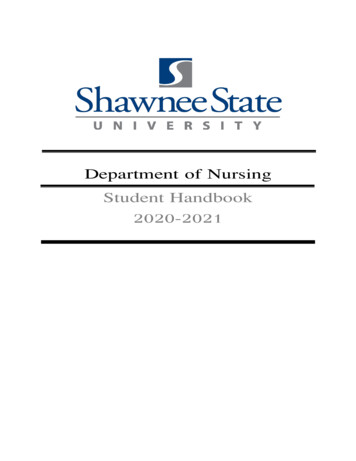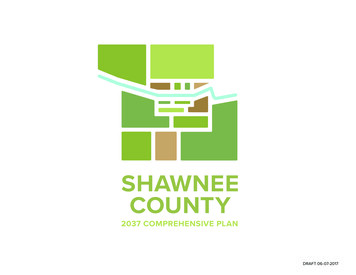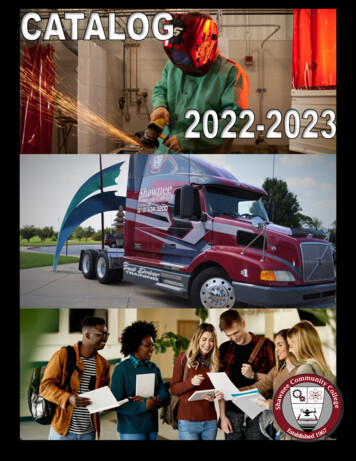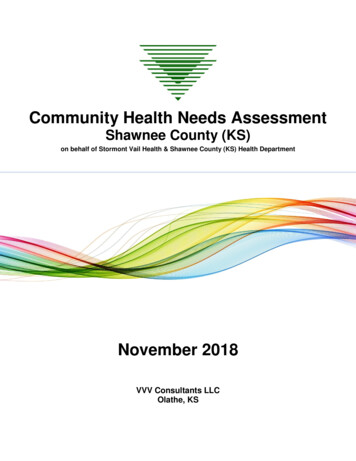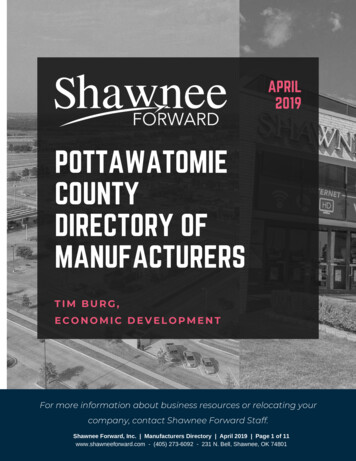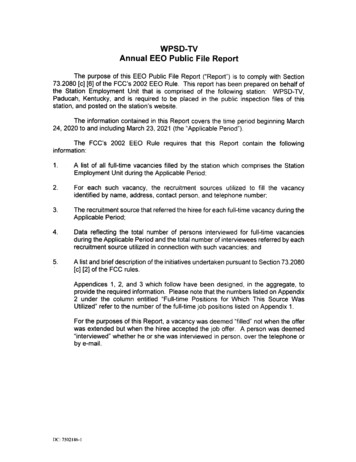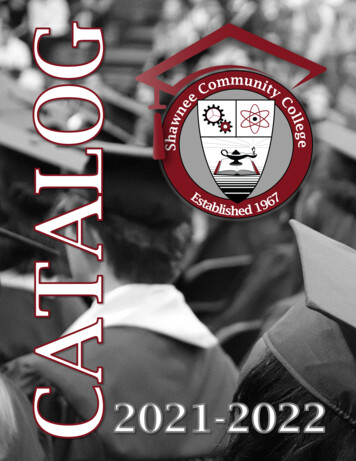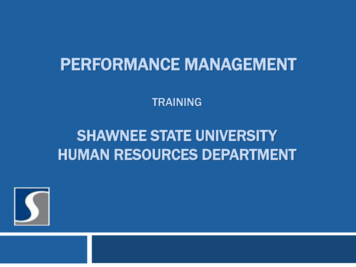
Transcription
PERFORMANCE MANAGEMENTTRAININGSHAWNEE STATE UNIVERSITYHUMAN RESOURCES DEPARTMENT
Agenda2I.Introduction & BackgroundII.ExpectationsIII.Orientation to the Performance Management SystemIV.Process and ScheduleV.Getting Started: Planning Phase/Goal SettingVI.PeopleAdmin System: Getting StartedVII.Next Steps
INTRODUCTION3 Roles of the HR teamBOT Charter for Staff DevelopmentFit of Performance Management in StaffDevelopmentGoals – Staff Development and PerformanceManagement
Roles of the HR Team4 Janet Zender – Asked by Dr. Boyles to assistin several Finance & Administrative projectimplementations Megan Ketter/Judi McGraw – On the groundresources to help you apply what you’velearned about performance management andthe PeopleAdmin system
BOT Charter for Staff Development5President’s Goals – Established in 2013Positioning SSU Human Resources for the FutureAs part of the Campus wide program reviews, Position SSU non-academic leaders for staff development, targetedrecruiting, and leadership transition supporting universitytransformation Create a clear vision of what SSU needs in leadership as wedevelop incumbents or hire non academic positions To ensure key leadership positions are meeting expectations Implement a staff development strategyRecruit to the visionEnsure individual professionals and support staff are included ininitiative to create a 21st Century Workforce
BOT Future Oriented Non-AcademicRole Profile6Job Description: “What” Summary Functions Duties andResponsibilities Minimum and preferredqualificationsCompetency Model: “How” Definition Actions Best PracticeSSU SpecificPriorities
Process7 5.6.7.8.Review Job Descriptions and orient them to the futureResearch the competencies required to lead SSUtoday and in the futureDevelop best practice competency modelsIntegrate the competency models into staffing processAssess current leaders against the leadershipcompetenciesExtend assessment to all Non-Academic PersonnelIdentify high leverage opportunities for improvementDesign and implement a staff development process
Staff Development Plan82015-16 Reviews New process New tools New schedule2015 Staff DevelopmentFocus: Training DevelopmentalAssignmentsStaff Development Policy - Sept 2015Alignment of supporting policies and procedures1.WorkforceDevelopmentVision& Strategy7.PerformanceEvaluation6.Training &Development2.FutureRolesFuture: ComprehensiveExec / AdminCompensationReviewNon-academicprogram reviews (NAPR)90%complete5.CapabilityEvaluation2014 Informal Baseline AssessmentEmployee and Supervisor only;No record to HR3.ObjectivesSet basedon NAPR(2015)10%reorganization4.Knowledge& SkillsNAPR Competency Models3/29/20168
9EXPECTATIONS SupervisorsEmployeeMulti-raters2nd Level SupervisorHuman Resources
Expectations10 Supervisors Participate in performance management of staffCommunicate to ensure mutual understandingContinuous coaching to clarify goals,responsibilities, priorities, expectations &performance feedbackIdentify & resolve performance problemsRecognize quality performance
Expectations11 Employee Responsible for professional developmentResponsible for ongoing self-evaluationUnderstanding jobs; they should be expertsPro-active in setting goals for their job
Expectations12 Multi-raters Provide input when asked2nd Level Supervisors Insure performance management system is beingused properlyUse the process to identify high potential employeeswho can take on more responsibilityBe aware of employees in their department/divisionwhose performance needs to improve
Expectations13 Human Resources Designs & manages the process and the softwareProvides coaching as neededEnsures the system and people using it stay onschedule and develop appropriate contentTrack probationary employees
14ORIENTATION TO THEPERFORMANCE MANAGEMENTSYSTEM BenefitsOverviewKey Definitions (Handout)Elements of the Performance ManagementSystemPhases for 2015/2016
Benefits of SSU’s PerformanceManagement System15 Recognizes quality performance. Identifies and resolves performance problems. Provides a basis for decisions such as promotions, succession andstrategic planning, and annual increases. Ensures SSU has the resources necessary to accomplish its openaccess regional mission today & in future. Ensures SSU has the right person in the right job at any given timetoday & in the future. Values & encourages employee development through a style ofmanagement which provides frequent feedback & fosters teamworkand adds value to the university by promoting improved jobperformance & encouraging skill development
Definition of Performance Management16An ongoing, continuous process that: Is one of the most important functions ofsupervisors, and is also important to thosethey superviseEmphasizes communication& mutual understandingbetween supervisor(s)& employeeAids in the clarification of job responsibilities,priorities & performance expectations
Performance Management iews &ResourcesExpectations& Tools forManagingPerformanceTraining &DevelopmentActivities
Key Definitions18 Handout
Elements of System19 Job Descriptions (Functions, Responsibilities, Duties,Minimum & Preferred Qualifications) Competencies (Leadership, Individual Professional,Support Staff) Review Process Goals/ObjectivesMeaningful DiscussionsElectronic Workflow & NotificationsRecordsMid-Year Check-inAnnual ReviewProbationary Reviews
Phases for 2015/201620The Performance Management Lifecyclecontains three key phases: Phase 1 – Planning PhasePhase 2 – Ongoing Coaching & FeedbackPhasePhase 3 – Evaluation/Review Phase
21PROCESS & SCHEDULE Processes & ProceduresSchedule
Performance Management Cycle2210EmployeeAcknowledgesPerformanceReviewApr - June1SupervisorReviewsEmployee’s wledgesPlan9PerformanceReviewDiscussion82nd eSupervisor& Employee2nd LevelSupervisorJuly - Sept7SupervisorCompletesReview4Mid-YearCheck-inDec - Jan6EmployeeCompletesSelf-Review5Assign MultiRater(optional)
23GETTING STARTED: PLANNINGPHASE/GOAL SETTING Types of Goals for the JobRatingsEffective Goal SettingTools
Planning Phase24 Occurs at the beginning of a review period Ideally also occurs any time performanceexpectations change Takes place through a conversation betweenan employee and her/his supervisor
Types of Goals for the Job25 Process Goals Project Goals Staff Development
Process Goals26Process Goals (the what) Ongoingresponsibilities where one managestasks within quality/quantity, cost, or timestandards Definewhat is to be accomplished by when, or inwhat frequency Areat the heart of every job description
Project Goals27Project Goals (the what) “Change”Results which improve or create newcapability, e.g. Performance Management Systemvs paper system.Job descriptions describe the job a person hasbeen hired to do. Specific job responsibilities driveperformance goals (both process and project).
Staff Development Goals28Core Competencies Goals (the How) Definedas the ability of an individual to do a jobproperly Setof defined knowledge and behaviors thatprovide a structured guide enabling theidentification, evaluation and development of thebehaviors in individual employees Listof behaviors associated with eachcompetency is included in the job description
Staff Development Goals29 Learning& development are important aspects ofa high performance culture & a satisfying job Employees& supervisors are co-accountable forprofessional development, with the supervisorsets environment & provides necessary resources Twoprofessional development goals should beset: one that leverages strength & one thataddresses an area for improvement or growth
Staff Development Goals30 A strength to leverage – How can the employeeleverage strength in a particular competency tocontribute in even greater ways to the departmentand the university? An area for improvement or growth todevelop – How might an employee strengthen anattribute and the ways in which she/he contributesby developing on one or more areas ofimprovement? Additional staff development goal – What jobrelated competency might the employee learn orstrengthen to increase job effectiveness?
For CWA Support Staff31 Focus on competencies At this time, 2 types of goals Improvementgoals Betterteam member Better dependability Personal Areadevelopment goalsemployee would like to develop
Staff Development Opportunities32Identify & schedule appropriate development opportunities that align withemployee’s goals. Examples:1.External Resources (Reading books, magazines or journals; newspaperarticles)2.Course Work (Evening adult education; extension or correspondencecourses; summer courses; seminars,workshops)3.On-the-Job Activities (Structured or informal feedback from managers,peers or direct reports)4.On-the-Job Assignments (New projects; vacation replacements;transfers; presentations/special assignments during meetings; after-workpractice sessions; switching jobs for a day; membership or leadership ofa task force committee; trading an objective with a peer; “Lead person”responsibilities; Representing your supervisor or group at a function)5.Modeling (Observing individuals with the skills youwant to develop; discussing your observations)6.Community group membership and leadership7.Membership and participation in professional or tradeassociation
Ratings33While performance planning does not include theprocess of rating performance, employees want toknow how their performance will be rated and whatit will take to reach the highest rating.For supervisors: It is your role to makethe judgments to rate the performanceof your employee.
SSU’s Rating Scale (Handout)34 Outstanding Performance (O) – The employee’s performance significantly and consistentlysurpassed job performance standards and requirements in all areas of responsibility whenmeasured by quality, quantity and value to the university. Demonstrated a personal commitmentto a high level of performance and results, even under challenging work goals. Examples arerequired to support your ratingExceeds Performance Requirements (E) – The employee frequently demonstrated performancebeyond job requirements in essential areas of responsibility and/or made contributions wellbeyond job demands. Took initiative in development and implementation of challenging workgoals. Examples are required to support your ratingMeets Performance Requirements (M) – The employee’s performance was steady and reliable,and consistently met the performance expectations of a fully qualified and experienced person inthis position. Errors were minimal and seldom repeated. Required normal supervision and followup and almost always completed work on schedule.In Development or Needs Improvement (NI) – The employee’s performance is still developingand/or did not consistently meet the requirements of the position in essential areas ofresponsibility. A performance improvement plan (PIP) may be required. Examples are required tosupport your ratingUnsatisfactory Performance (U) - The employee’s performance was consistently below therequirements of the position in essential areas of responsibility or the employee failed to makereasonable progress on a performance improvement plan. A performance improvement plan (PIP)must be established. Examples are required to support your ratingNew (N) (Too New to Evaluate) (Developing in a new position held less than 6 months.)
SSU’s Rating Scale35 In performance planning, supervisors & employees shoulddiscuss what daily behaviors & cumulative performanceresults will produce each of the ratings on the scale. Note: “Meets” is a good rating. Often an employee willcorrelate “meets” with the letter “C”. While it is easy to thinkthis way out of habit, it is not accurate in measuringprofessional performance. Satisfactory or acceptable performance means the employeeis contributing at a good level. He/she is meeting allexpectations. “Outstanding” or “Exceeds” should be used to recognizeemployees who exceed the expectations outlined in theirperformance objectives or who perform far above & beyondthose who meet expectations – STANDARD SETTERS.
SSU’s Rating Scale36 The same ratings are used for the competencies.Again, “meets” is a good rating. This indicates theemployee is living the competency; behaving in waysthat are consistent with the competency. “Exceeds” or “Outstanding” implies the employee is arecognized leader in modeling the behaviors alignedwith the competency. Coaching for success and towards achievement of thegoals should be provided at each check-in meetingand progress will be documented at the time ofreviewing performance.
Effective Goal Setting37SMART GoalsTo ensure maximum understanding between an employee and her/hissupervisor, write objectives with the following criteria in mind:* S – Specific (Clear statement of what needs to beachieved; this needs to be OBSERVABLE)* M – Measurable (Can be evaluated to determinewhether they have been accomplished withstandards of quantity, quality, cost & TIME)A – Action-oriented/Attainable/Achievable(Clear steps or procedures to achieve goal; not toolofty)R – Realistic (Do you have the time, money, man-power orresources and is it relevant?T – Timely/Time-bound (Clear deadline by which agoal will be achieved, including milestones)
38“Failing to planisplanning to fail.”
Tools39Handouts
40PEOPLEADMIN SYSTEM: GETTINGSTARTED Navigation to Performance ManagementSetting Goals Supervisor RoleEmployee Role
Navigation to PerformanceManagement41PeopleAdmin is a development tool tohelp define high potential performance &developmental opportunities foremployees Will aid in succession planning, careerprogression, retention, course correction& employee relations
Program Overview42 Supervisors will outline expectations by creating an objective planfor their employee with the employee’s input at the beginning ofthe evaluation period. Together the supervisor and the Employee will utilize the plan forcheck-ins and as a tool for on-going communication. Supervisors should engage in regularly scheduled meetings toreview their employee’s performance, assess goals and timelines,and maintain open and on-going communication with theiremployee. Throughout the year, employees and supervisors complete privateprogress notes. Staff employees hired prior to July 1 of each year will be included inthat year’s program. Employees hired on or after July 1 will beincluded in the probationary program.
43“The single biggest problemwith COMMUNICATION is theillusion that it has takenplace.”- George Bernard Shaw
Setting Goals44 Supervisor Role Review employee’s job descriptionNotify HR of any changesMeet with employee to create plan (review job description, set goals,agree on plan). Clarify responsibilities and expectations.Enter the plan in PeopleAdminPeriodically take a minute to re-read your employee’s goals, look attheir performance & see whether their behavior matches their goals.Use Progress NotesEmployee Role In preparation for meeting with supervisor, review job descriptionComplete the form “EMPLOYEE PREPARATION FOR CREATINGTHE PLAN”Acknowledge plan in PeopleAdminPeriodically take a minute to re-read your goals, look at yourperformance & see whether your behavior matches your goals.Use Progress Notes
45NEXT STEPS
Next Steps46 Complete your responsibilities for the first phase Supervisor Role Review employee’s job description Notify HR of any changes Meet with employee to create plan (review job description, set goals, agree on plan).Clarify responsibilities and expectations. Enter the plan in PeopleAdmin Periodically take a minute to re-read your employee’s goals, look at their performance &see whether their behavior matches their goals. Use Progress NotesEmployee Role In preparation for meeting with supervisor, review job description Complete the form “EMPLOYEE PREPARATION FOR CREATING THE PLAN” Acknowledge plan in PeopleAdmin Periodically take a minute to re-read your goals, look at your performance & see whetheryour behavior matches your goals. Use Progress NotesIf you have problems, questions, or issues – contact Megan, Judi, or JanetBe ready for mid-year check in – Progress Notes
Performance Management Cycle 22 Apr - June Dec - Jan Supervisor Employee Supervisor & Employee 2nd Level Supervisor 1 Supervisor Reviews u o}Ç [ Job Description 2 Supervisor Creates Plan 6 Employee Completes Self-Review 5 Assign Multi-Rater (optional) 3 Employee Acknowledges Plan 4 Mid -Year Check-in 7
